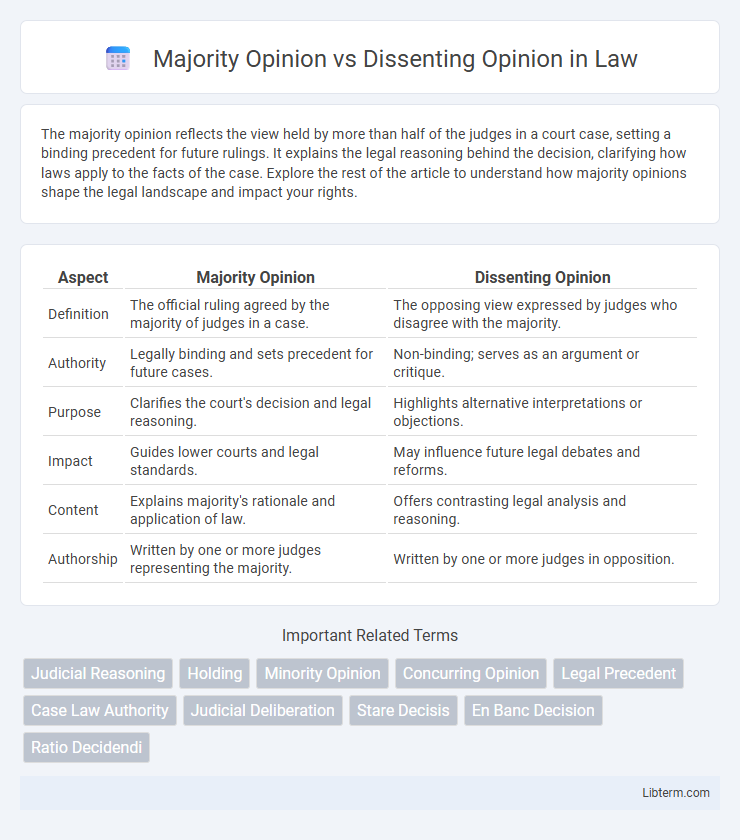The majority opinion reflects the view held by more than half of the judges in a court case, setting a binding precedent for future rulings. It explains the legal reasoning behind the decision, clarifying how laws apply to the facts of the case. Explore the rest of the article to understand how majority opinions shape the legal landscape and impact your rights.
Table of Comparison
| Aspect | Majority Opinion | Dissenting Opinion |
|---|---|---|
| Definition | The official ruling agreed by the majority of judges in a case. | The opposing view expressed by judges who disagree with the majority. |
| Authority | Legally binding and sets precedent for future cases. | Non-binding; serves as an argument or critique. |
| Purpose | Clarifies the court's decision and legal reasoning. | Highlights alternative interpretations or objections. |
| Impact | Guides lower courts and legal standards. | May influence future legal debates and reforms. |
| Content | Explains majority's rationale and application of law. | Offers contrasting legal analysis and reasoning. |
| Authorship | Written by one or more judges representing the majority. | Written by one or more judges in opposition. |
Understanding Majority and Dissenting Opinions
Majority opinions represent the official ruling of a court, reflecting the consensus of most judges and establishing binding precedent on legal issues. Dissenting opinions provide alternative legal reasoning from judges who disagree with the majority, highlighting different interpretations and potential flaws in the ruling. Understanding both opinions is crucial for comprehending the court's decision-making process and future legal implications.
Historical Background of Judicial Opinions
Judicial opinions originated in English common law, where judges established legal precedents by explaining their rulings. The Majority Opinion emerged as the authoritative ruling reflecting the view of most justices in a case, while Dissenting Opinions appeared to record disagreements, providing alternate legal reasoning. Historically, dissents became crucial for legal development, influencing future cases and shaping evolving interpretations of law.
Defining Majority Opinion in Court Rulings
The majority opinion in court rulings represents the official judicial decision agreed upon by more than half of the judges or justices participating in the case. This opinion outlines the legal rationale and principles that form the binding precedent for lower courts and future cases. It carries authoritative weight, guiding interpretation of laws and influencing the development of legal doctrines.
Key Functions of Dissenting Opinions
Dissenting opinions serve the crucial role of challenging the majority's interpretation of the law, preserving alternative legal viewpoints that can influence future cases and legislative reforms. They provide a detailed critique of the majority's reasoning, offering insights that may shape the evolution of legal principles over time. By maintaining a record of judicial disagreement, dissenting opinions contribute to the dynamic development of jurisprudence and reinforce the integrity of the judicial process.
Structure and Elements of Each Opinion
A majority opinion presents the Court's official ruling and rationale, structured with a clear statement of facts, legal issues, analysis grounded in precedent, and the final verdict. It includes the judgment, supporting legal principles, and explanations justifying the decision, often authored by one or more justices representing the majority. A dissenting opinion offers a contrasting viewpoint, structured similarly with factual and legal analysis but aims to highlight disagreements with the majority's interpretation, legal reasoning, or application, emphasizing alternative perspectives or concerns about implications.
Influence of Majority Opinions on Legal Precedent
Majority opinions establish binding legal precedent that courts follow in subsequent cases, shaping the interpretation and application of laws. These opinions provide authoritative guidance by articulating the court's reasoning, which influences future judicial decisions and legislative developments. The widespread adherence to majority opinions ensures consistency and predictability in the legal system.
The Role of Dissenting Opinions in Legal Evolution
Dissenting opinions play a crucial role in the evolution of legal doctrines by challenging the prevailing majority view and presenting alternative interpretations of the law. These opinions provide a foundation for future legal debates and can influence subsequent court rulings, legislative changes, and shifts in societal values. Over time, dissenting opinions often become authoritative references that contribute to the dynamic development of legal principles and justice.
Famous Examples: Noteworthy Majority and Dissenting Opinions
The landmark Supreme Court case Brown v. Board of Education showcased a powerful majority opinion that declared racial segregation in public schools unconstitutional, reshaping civil rights law. In contrast, Justice John Marshall Harlan's famous dissent in Plessy v. Ferguson argued vehemently against the "separate but equal" doctrine, highlighting early resistance to racial segregation. These iconic majority and dissenting opinions exemplify how judicial perspectives can profoundly influence legal precedent and societal values.
Impact on Future Case Law and Legislation
Majority opinions establish binding precedents that guide court decisions and influence the development of legislation, shaping legal standards and societal norms. Dissenting opinions, while not legally binding, provide critical perspectives that can inspire future legal challenges and judicial reforms, often serving as a foundation for eventual shifts in case law. Over time, dissenting views may gain acceptance, prompting courts and lawmakers to revisit and modify established rules or statutes.
Comparative Analysis: Majority Opinion vs Dissenting Opinion
Majority opinions represent the official ruling of a court, reflecting the consensus that establishes legal precedent and binds lower courts, while dissenting opinions provide alternative viewpoints that challenge the majority's interpretation and may influence future legal developments. Majority opinions prioritize clarity and authority, often shaping statutory and constitutional law, whereas dissenting opinions emphasize judicial reasoning and critique, fostering ongoing legal debate. Comparative analysis highlights the majority's role in law-making and the dissent's function in preserving judicial plurality and potential reform.
Majority Opinion Infographic

 libterm.com
libterm.com